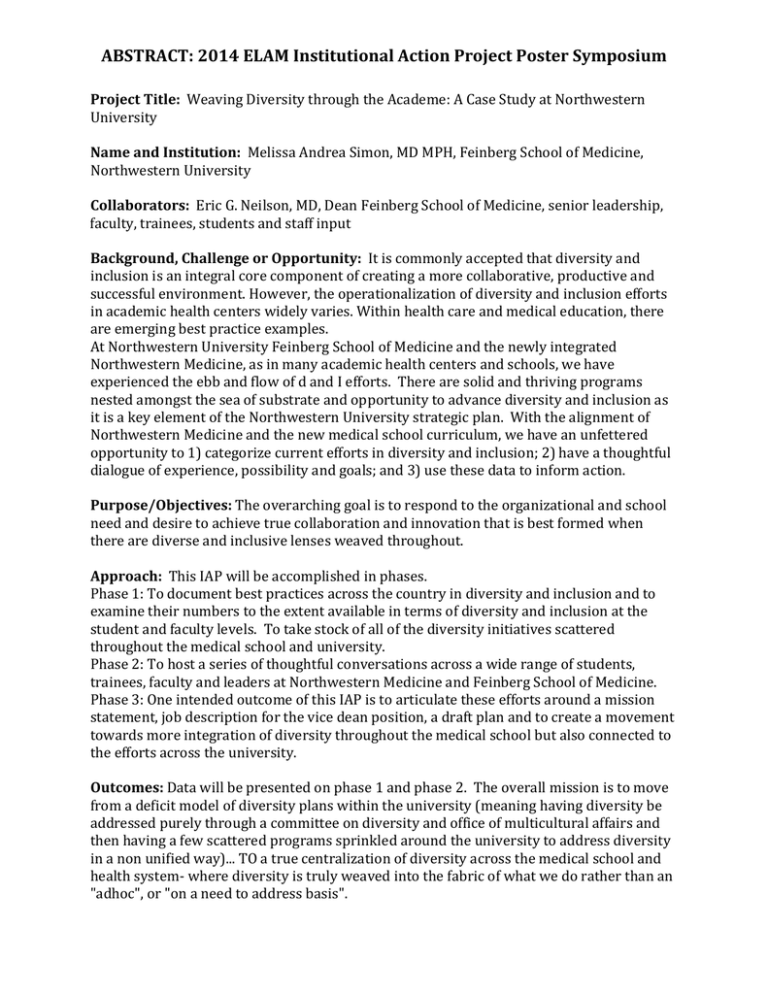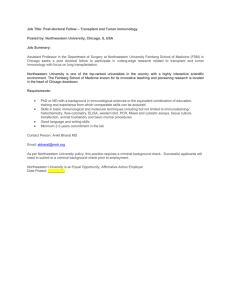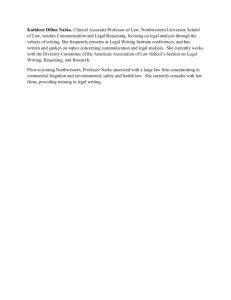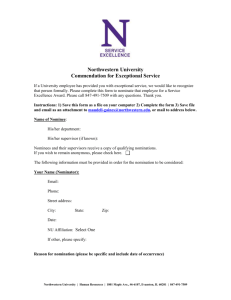ABSTRACT: 2014 ELAM Institutional Action Project Poster Symposium
advertisement

ABSTRACT: 2014 ELAM Institutional Action Project Poster Symposium Project Title: Weaving Diversity through the Academe: A Case Study at Northwestern University Name and Institution: Melissa Andrea Simon, MD MPH, Feinberg School of Medicine, Northwestern University Collaborators: Eric G. Neilson, MD, Dean Feinberg School of Medicine, senior leadership, faculty, trainees, students and staff input Background, Challenge or Opportunity: It is commonly accepted that diversity and inclusion is an integral core component of creating a more collaborative, productive and successful environment. However, the operationalization of diversity and inclusion efforts in academic health centers widely varies. Within health care and medical education, there are emerging best practice examples. At Northwestern University Feinberg School of Medicine and the newly integrated Northwestern Medicine, as in many academic health centers and schools, we have experienced the ebb and flow of d and I efforts. There are solid and thriving programs nested amongst the sea of substrate and opportunity to advance diversity and inclusion as it is a key element of the Northwestern University strategic plan. With the alignment of Northwestern Medicine and the new medical school curriculum, we have an unfettered opportunity to 1) categorize current efforts in diversity and inclusion; 2) have a thoughtful dialogue of experience, possibility and goals; and 3) use these data to inform action. Purpose/Objectives: The overarching goal is to respond to the organizational and school need and desire to achieve true collaboration and innovation that is best formed when there are diverse and inclusive lenses weaved throughout. Approach: This IAP will be accomplished in phases. Phase 1: To document best practices across the country in diversity and inclusion and to examine their numbers to the extent available in terms of diversity and inclusion at the student and faculty levels. To take stock of all of the diversity initiatives scattered throughout the medical school and university. Phase 2: To host a series of thoughtful conversations across a wide range of students, trainees, faculty and leaders at Northwestern Medicine and Feinberg School of Medicine. Phase 3: One intended outcome of this IAP is to articulate these efforts around a mission statement, job description for the vice dean position, a draft plan and to create a movement towards more integration of diversity throughout the medical school but also connected to the efforts across the university. Outcomes: Data will be presented on phase 1 and phase 2. The overall mission is to move from a deficit model of diversity plans within the university (meaning having diversity be addressed purely through a committee on diversity and office of multicultural affairs and then having a few scattered programs sprinkled around the university to address diversity in a non unified way)... TO a true centralization of diversity across the medical school and health system- where diversity is truly weaved into the fabric of what we do rather than an "adhoc", or "on a need to address basis". Weaving Diversity through the Academe: A Case Study at Northwestern Feinberg School of Medicine Melissa Andrea Simon, MD MPH Departments of Obstetrics and Gynecology, Preventive Medicine, and Medical Social Sciences Collaborator: Dr. Eric G. Neilson, Dean Feinberg School of Medicine at Northwestern University BACKGROUND APPROACH AND OUTCOMES • It is commonly accepted that diversity and inclusion (D and I) Thoughtful Dialogue Excerpts from the Dialogue • Between January and April, we conducted a series of 54 is an integral core component of creating a more Participants • 54 conversations with leaders, faculty, trainees, thoughtful conversations regarding D and I. Stakeholders collaborative, productive, innovative and overall successful students and staff included faculty, trainees, students, staff and leaders in eorganization various departments and functions across FSM and NM. Unanimous • Unanimously positive response in support of the • Challenge: Operationalization of D and I efforts in academic Select need for more intentional and public D and I efforts • Areas of inquiry included: health centers widely varies and ebb and flow with and support Responses • Perceived D and I climate, culture and need leadership change. • Unanimous statement that D and I efforts need to be • Areas where D and I efforts are thriving promoted, elevated and amplified through senior • Opportunities to improve D and I efforts • Opportunity: Northwestern Medicine (NM) has just leadership in an ongoing rather than sporadic way • Use of metrics to promote D and I integrated and there has just been major curricular change at • It is going to take strong resources • Other considerations Feinberg School of Medicine (FSM) and there is much • It is going to take a full complementary team across Cataloguing Diversity and Inclusion Efforts forward momentum for positive change in all mission NM and FSM to accomplish true integration of D and • There are several thriving programs at NM and FSM spheres. I efforts that help support D and I efforts mostly focused on OBJECTIVE students and residents these programs need more • To respond to NM and FSM need and desire to achieve true support and amplication DISCUSSION AND NEXT STEPS collaboration and innovation that is best created when D and I • There are weak efforts aimed at faculty, fellows and SUMMARY efforts are weaved into the institutional fabric. patient care and many opportunites to address this. WILL + RESOURCE are required. A TEAM is Required. APPROACH • To meet this lofy goal, this project required phased planning and unveiling. Phase 1 current To identify best practices at peer institutions and in other sectors. To take stock of our efforts at FSM and NM Phase 2 To host a series of thoughtful dialogues across a wide range of FSM and NM stakeholders • Addressing D and I intentionally is critical in today’s medical schools and health care organizations. It is only through intentionality and true support with demonstrated will and resource from leadership that will champion D and I and thus help weave it into the fabric of the institution. • There are pockets of D and I excellence scattered throughout FSM and NM. Much effort is focused on medical students with attention to trainees second. • There are opportunities to better address D and I as it relates to patient care and, cultural competency and fellows and faculty IMPACT Phase 3 To articulate these efforts around a leadership driven mission statement, job and team description what a D and I teamForum at NM and FSM should look like, and a draft plan of Presented at thefor 2014 ELAM ® Leaders • This dialogue has made it clear that there is will to help propel these efforts in multiple dimensions across NM and FSM. NEXT STEPS To articulate this will and coalesce an implementation team with resource and direct report to top leadership at FSM and NM






